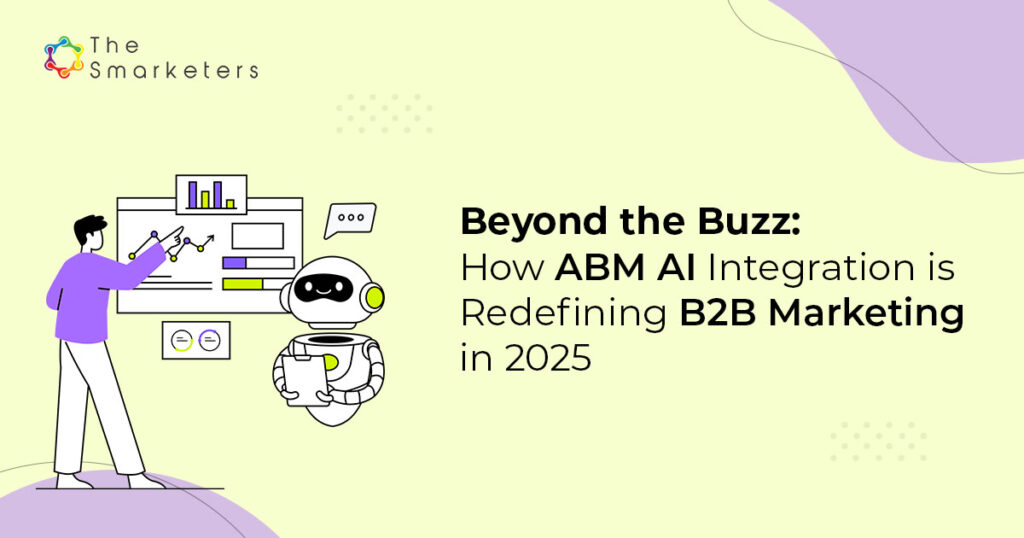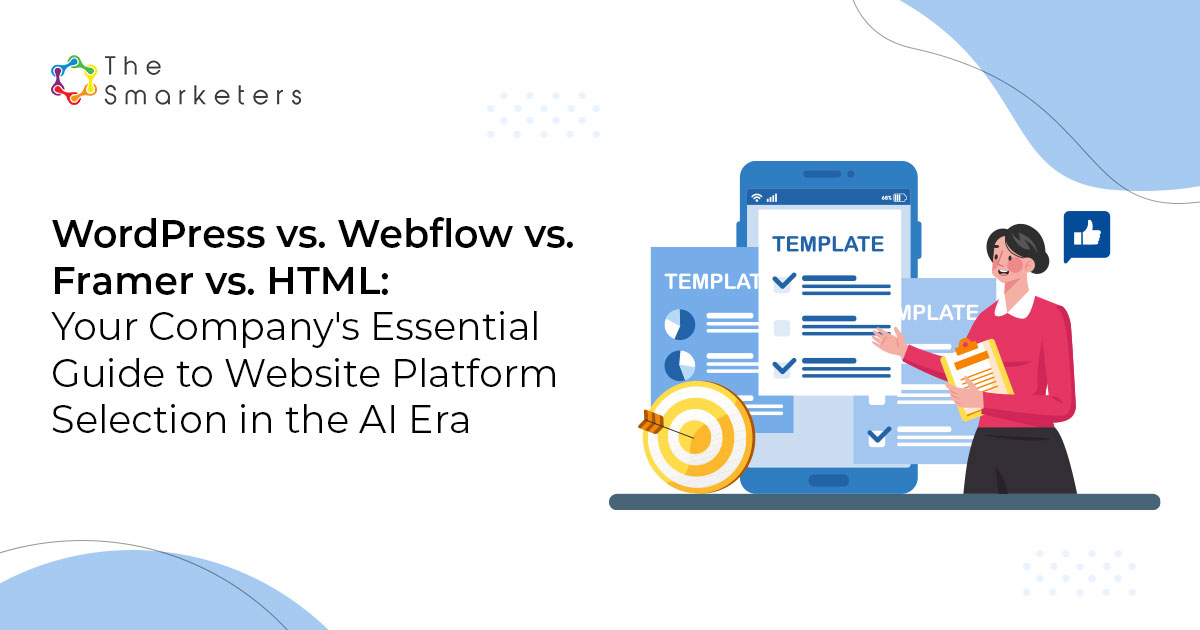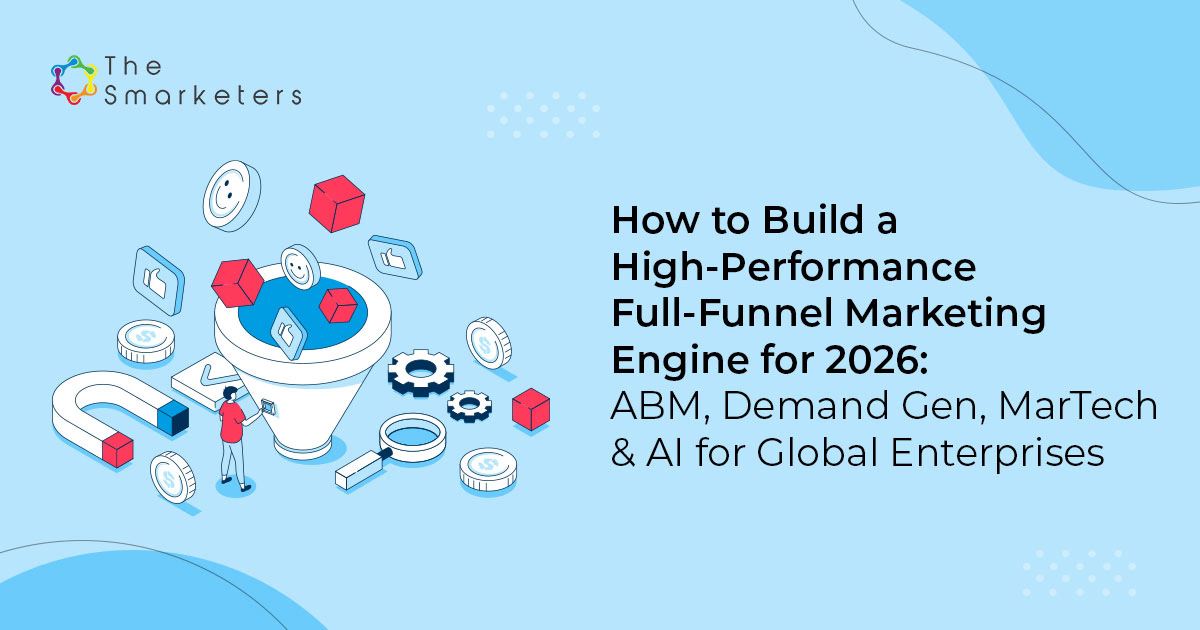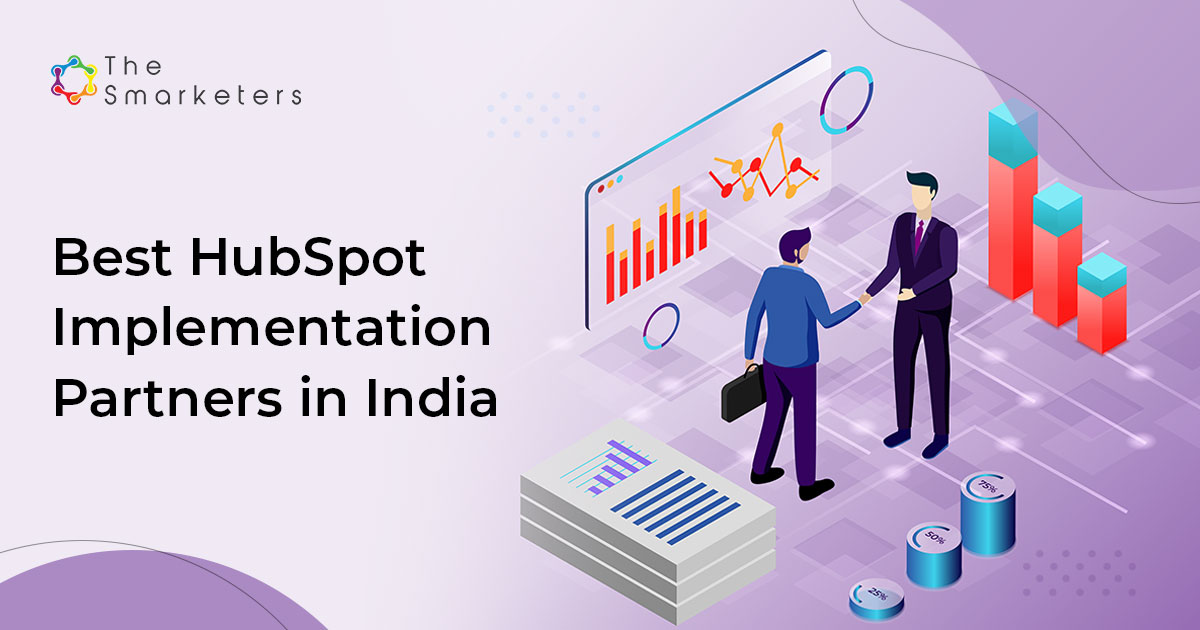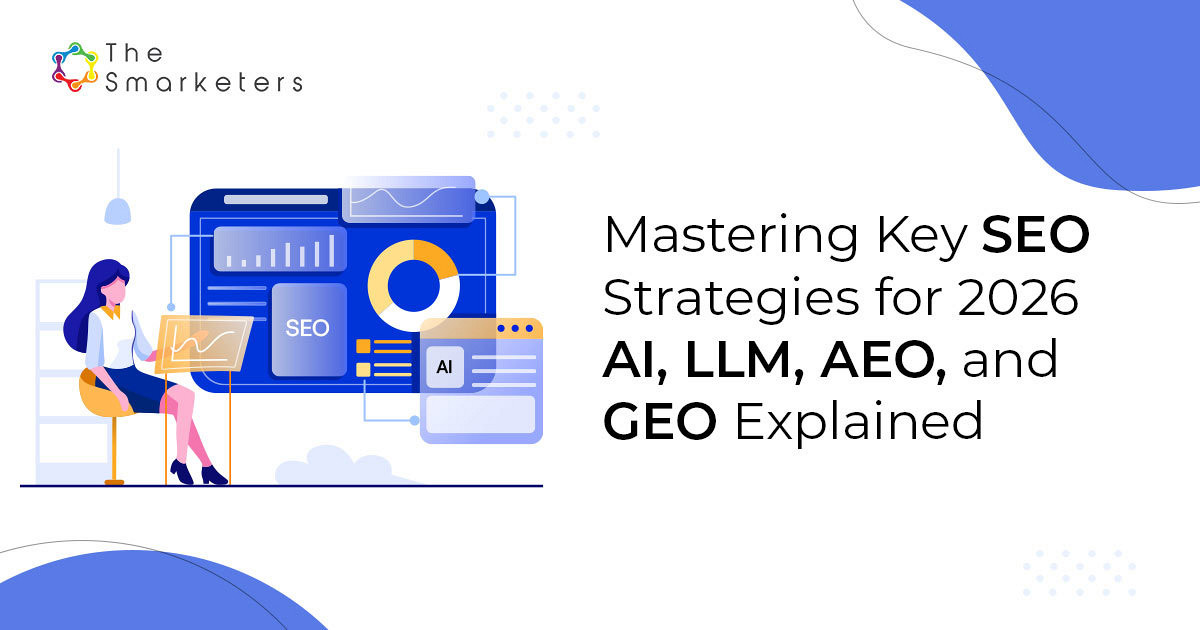Table of Contents
- Key Takeaways
- The New Reality : From Traditional ABM to AI-Powered Transformation
- The Tangible Business Outcomes of ABM AI Integration
- Navigating the ABM AI Integration Journey: A Strategic Roadmap
- Essential AI ABM Tools Every Business Should Know
- The Smarketers : Your Partner in the AI-Powered ABM Revolution
- The Future is Now
- FAQs
- Winning Inbound Marketing Tactics for 2026: AI, Hyper-personalization, and Beyond
- How to Build a High-Performance Full-Funnel Marketing Engine for 2026: ABM, Demand Gen, MarTech & AI for Global Enterprises
- Top 10 B2B Marketing Companies in India with Technology and SaaS Expertise
- Top 10 ABM Companies in India: Your Complete Guide to Finding the Right Partner in 2026
- 2026 Marketing Guide: Integrating AI, MarTech Tools, and Smart Automations
Key Takeaways
- ABM AI integration is transforming B2B marketing from reactive to predictive, enabling businesses to engage prospects before they begin their buying journey
- The AI-Powered ABM Flywheel concept creates a self-reinforcing cycle of predictive intelligence, hyper-personalization, dynamic engagement, and continuous optimization
- Leading AI ABM platforms like 6sense, Demandbase, and Terminus offer distinct capabilities—from intent modeling to B2B advertising to multi-channel orchestration
- LLMs revolutionize account identification by analyzing unstructured data sources like executive communications and social sentiment for deeper insights
- Two emerging ABM models are reshaping the landscape: Predictive ABM with autonomous triggers and Autonomous ABM with self-executing campaigns
- Strategic implementation requires four key steps: building data foundations, fostering sales-marketing alignment, investing in integrated technology, and starting with pilot programs
- Success demands balancing AI automation with human relationship building—the most sophisticated tools are only effective with proper strategy and execution
The world of B2B marketing is in a constant state of flux, but few shifts have been as transformative as the integration of Artificial Intelligence (AI) into Account-Based Marketing (ABM). While the concept of ABM has been around for years, the infusion of AI is elevating it from a targeted marketing strategy to a predictive, personalized, and powerful revenue engine. This isn’t just about automating tasks; it’s about fundamentally reshaping how businesses identify, engage, and win their most valuable accounts.
If you’re still thinking about ABM in terms of manual account selection and generic email cadences, you’re already behind. The future of ABM is here, and it’s powered by AI. In this blog, we’ll explore how this integration goes beyond simple automation to deliver unprecedented business outcomes, and how you can strategically navigate this new landscape.
The New Reality : From Traditional ABM to AI-Powered Transformation
For years, ABM has been a proven strategy for focusing marketing and sales efforts on high-value accounts. However, traditional ABM has often been limited by manual processes, incomplete data, and a lack of scalability. AI is shattering these limitations, creating a new paradigm for account-based strategies. The difference is stark:
| Feature | Traditional ABM | AI-Powered ABM |
|---|---|---|
| Account Selection | Manual, based on firmographics and intuition | Predictive, based on real-time intent data and lookalike modeling |
| Personalization | Segment-level, often limited to industry or company size | Hyper-personalized at the individual level, based on behavioral data |
| Engagement | Pre-scheduled campaigns across multiple channels | Dynamic, real-time engagement on the most effective channels |
| Measurement | Manual reporting, often with a long feedback loop | Automated, real-time analytics with predictive insights |
This shift represents a move from a reactive to a proactive approach. Instead of waiting for accounts to show interest, AI-powered ABM predicts which accounts are in-market and engages them with personalized experiences before they even begin their buying journey.
The AI-Powered ABM Flywheel : A Virtuous Cycle of Intelligence

To truly understand the power of ABM AI integration, it’s helpful to think of it as a flywheel—a self-reinforcing loop that gains momentum over time. Each stage of the flywheel is powered by AI, and each interaction feeds back into the system, making it smarter and more effective.
- Predictive Intelligence: At the core of the flywheel is the ability to predict which accounts are most likely to buy. AI models analyze vast datasets—including firmographics, technographics, intent data, and historical customer data—to identify high-propensity accounts with startling accuracy. This allows marketing and sales teams to focus their resources where they’ll have the greatest impact.
- Hyper-Personalization at Scale: Once the right accounts are identified, AI gets to work crafting personalized experiences for each one. This goes far beyond inserting a company name into an email. AI can dynamically tailor website content, recommend relevant blog posts and case studies, and even personalize ad copy—all in real-time, based on the individual’s behavior and interests.
- Dynamic Engagement: With personalized content in hand, the next step is to engage the account across multiple channels. AI optimizes this process by determining the best channels and times to engage each individual, whether it’s through email, social media, display ads, or sales outreach. This ensures that the right message reaches the right person at the right time, every time.
- Continuous Optimization: The final stage of the flywheel is where the magic really happens. Every interaction—every click, every download, every sales conversation—is captured and fed back into the AI models. This creates a continuous learning loop that refines the predictive models, improves personalization, and optimizes engagement strategies over time. The result is an ABM program that gets smarter and more effective with every interaction.
The Tangible Business Outcomes of ABM AI Integration
The shift to AI-powered ABM isn’t just a theoretical exercise; it’s delivering real, measurable results for B2B organizations. The data speaks for itself :
- Revenue Growth: An astounding 79% of marketers who use AI in their ABM programs report increased revenue .
- Pipeline Velocity: Some companies have seen pipeline increases of up to 285% and have reduced their average sales cycle by as much as 28 days .
- Deal Size and Win Rates: By focusing on high-propensity accounts, businesses are seeing a 50% increase in average deal size and a significant improvement in win rates .
- Customer Lifetime Value (CLV): The hyper-personalization enabled by AI fosters stronger customer relationships, leading to improved customer lifetime value.
These are not just incremental improvements; they are game-changing results that are giving early adopters a significant competitive advantage.
Navigating the ABM AI Integration Journey: A Strategic Roadmap
Embarking on an ABM AI integration journey can seem daunting, but with a strategic approach, any B2B organization can reap the rewards. Here’s a roadmap to get you started :
- Build a Solid Data Foundation: AI is only as good as the data it’s fed. Before you can leverage AI-powered ABM, you need to ensure you have clean, accurate, and integrated data from your CRM, marketing automation platform, and other key systems.
- Foster Sales and Marketing Alignment: ABM has always been a team sport, and AI makes sales and marketing alignment more critical than ever. Both teams need to be involved in defining target account criteria, developing messaging, and executing campaigns.
- Invest in the Right Technology Stack: A number of powerful AI-powered ABM platforms are available, including 6sense, Demandbase, and Terminus. The key is to choose a platform that integrates with your existing technology stack and provides the features and capabilities you need to achieve your goals.
- Start with a Pilot Program: Don’t try to boil the ocean. Start with a small, focused pilot program to test your approach, prove the value of AI-powered ABM, and generate early wins. This will help you build momentum and secure buy-in for a broader rollout.
Essential AI ABM Tools Every Business Should Know
The AI ABM landscape is rich with innovative platforms, each offering unique capabilities to transform your account-based marketing efforts. Understanding the strengths of leading tools can help you make informed decisions about your technology stack.
The AI-Powered Leaders
6sense stands out as the premier platform for AI modeling based on intent data . Its predictive analytics capabilities enable businesses to identify accounts showing buying signals with remarkable accuracy. The platform excels at providing real-time insights that help marketing and sales teams engage prospects at the optimal moment in their buying journey.
Demandbase has established itself as the leader in ABM advertising, featuring the only demand-side platform (DSP) built specifically for B2B . What sets Demandbase apart is its ability to balance impressions across target accounts and track multi-channel campaigns with precision. According to G2 reviews, Demandbase consistently earns higher ratings than competitors across multiple categories.
Terminus focuses on multi-channel ABM orchestration, enabling businesses to coordinate campaigns across email, LinkedIn, display ads, and direct mail from a single platform . Companies using Terminus report significant improvements in conversion rates, with some seeing increases of up to 50%.
Emerging AI-Driven Platforms
Factors.ai represents the new generation of AI-powered ABM platforms, offering advanced intent capture that can identify up to 64% of website traffic through sophisticated IP lookup technology. Its workflow automation capabilities and LinkedIn AdPilot feature make it particularly attractive for businesses looking to enhance their LinkedIn advertising ROI.
HubSpot ABM provides seamless integration within the HubSpot ecosystem, making it an ideal choice for businesses already using HubSpot’s CRM and marketing automation tools. The platform’s strength lies in its ability to coordinate multi-channel campaigns while maintaining data consistency across all touchpoints.
Key Selection Criteria
When evaluating AI ABM platforms, consider these essential capabilities :
| Feature Category | Must-Have Capabilities |
|---|---|
| Intent Intelligence | Real-time buying signal detection, predictive account scoring |
| Personalization Engine | Dynamic content customization, behavioral targeting |
| Multi-Channel Orchestration | Email, social, display, and direct mail coordination |
| Integration Capabilities | CRM, marketing automation, and data enrichment connectivity |
| Analytics & Attribution | Account-level reporting, revenue attribution, and ROI measurement |
The right platform should not only provide these features but also scale with your business growth and integrate seamlessly with your existing technology stack. Remember, the most sophisticated tool is only as effective as your strategy and execution.
The Smarketers : Your Partner in the AI-Powered ABM Revolution

Successfully navigating the shift to AI-powered ABM requires more than just technology; it requires a strategic partner with the expertise to guide you through the process. This is where The Smarketers comes in.
At The Smarketers, we live and breathe B2B marketing, and we’ve been at the forefront of the ABM revolution. We understand that true transformation comes not just from implementing new tools, but from developing a holistic strategy that aligns your people, processes, and technology.
Our approach is built on a deep understanding of the B2B landscape and a proven methodology for delivering results. We help our clients:
- Develop a Strategic ABM Framework: Our 6-step approach covers everything from identifying high-value accounts to nurturing them through the long B2B sales cycle.
- Integrate the Right MarTech Stack: We are tool-agnostic and have deep expertise in integrating leading ABM and marketing automation platforms, including HubSpot, Salesforce, 6sense, and Demandbase.
- Drive Measurable Business Outcomes: We are an ROI-focused agency, and we work with our clients to define and track the KPIs that matter most to their business.
Whether you’re just beginning your ABM journey or looking to infuse your existing strategy with the power of AI, The Smarketers can help. We’ll work with you to develop a customized roadmap for success and provide the hands-on support you need to achieve your goals.
The Future is Now
The integration of AI into ABM is not a distant future; it’s a present-day reality that is separating the laggards from the leaders in the B2B world. By embracing this transformation, you can unlock unprecedented levels of efficiency, personalization, and revenue growth. The journey may seem complex, but with the right strategy and the right partner, the rewards are well worth the effort.
FAQs
1. Can AI-powered LLMs help identify high-value accounts beyond firmographics and intent data? How?
Absolutely. Large Language Models represent a quantum leap in account identification capabilities, going far beyond traditional firmographics and intent signals. LLMs can analyze unstructured data sources that were previously impossible to process at scale, including executive communications, earnings call transcripts, company news, social media sentiment, and even job posting patterns that indicate technology adoption or organizational changes .
For example, an LLM can analyze a CEO’s recent interview to identify strategic priorities, correlate this with patent filings to understand innovation directions, and cross-reference social media activity to gauge market sentiment—all to determine if an account is entering a buying cycle. This multi-dimensional analysis provides a 360-degree view of account readiness that traditional scoring methods simply cannot match.
2. What are the emerging ABM models (e.g., predictive ABM, autonomous ABM) powered by generative AI and LLMs?
Two revolutionary models are reshaping the ABM landscape :
Predictive ABM leverages AI-first orchestration where predictive models run autonomously, triggering campaigns without manual input based on real-time buyer intent signals . This model can predict account behavior with up to 95% accuracy, compared to 50% with traditional methods, enabling marketers to engage prospects before they even begin their buying journey.
Autonomous ABM represents the next evolution, featuring self-executing campaigns that make real-time decisions about engagement timing, channel selection, and content personalization. These systems continuously learn and optimize without human intervention, creating a truly intelligent marketing engine that adapts to each account’s unique behavioral patterns and preferences.
3. What are the most effective prompts or strategies to use LLMs for crafting personalized outreach by account tier (1:1, 1:few, 1:many)?
The key to effective LLM-powered personalization lies in structured prompt engineering tailored to each ABM tier :
For 1:1 (Strategic Accounts) : Use comprehensive prompts that incorporate multiple data sources: “Analyze [Account Name]’s recent earnings call, CEO’s LinkedIn activity, and our CRM engagement history to craft a personalized email addressing their specific digital transformation challenges, referencing their Q3 growth initiatives and connecting to our [specific solution].”
For 1:Few (Industry Segments) : Focus on shared characteristics while maintaining relevance: “Create personalized outreach for healthcare CFOs facing regulatory compliance challenges, incorporating industry-specific pain points, recent healthcare legislation impacts, and tailored value propositions for each account’s size and complexity.”
For 1:Many (Market Segments) : Leverage dynamic personalization at scale: “Generate email variations for mid-market SaaS companies, personalizing subject lines with company-specific growth metrics, customizing pain points based on their technology stack, and adjusting CTAs based on their current market position.”
4. How do LLMs support real-time buyer journey analysis and adaptive ABM playbooks?
LLMs excel at processing and correlating multiple data streams in real-time to create dynamic buyer journey maps. They can analyze website behavior, content consumption patterns, social media engagement, and sales interactions to identify exactly where each account stands in their buying process.
The adaptive playbook capability is particularly powerful—LLMs can automatically adjust engagement strategies based on behavioral signals. For instance, if an account suddenly increases research activity around competitive solutions, the LLM can trigger a competitive differentiation playbook, automatically generating relevant content and alerting sales teams to engage with specific messaging.
This real-time adaptation ensures that every touchpoint is contextually relevant and strategically timed, dramatically improving conversion rates and shortening sales cycles.
5. How do you measure ROI from ABM AI integration initiatives?
Measuring ABM AI integration ROI requires a multi-layered approach that goes beyond traditional metrics. Key performance indicators should include pipeline velocity improvements (companies report up to 30% reduction in sales cycles), deal size increases (up to 50% larger deals), and engagement quality metrics (20% higher engagement rates with AI-powered personalization) .
Advanced attribution models powered by AI can track the customer journey across multiple touchpoints, providing clear visibility into which AI-driven activities contribute most to revenue. The most successful organizations also measure efficiency gains—such as time saved on manual tasks, improved lead quality scores, and increased sales and marketing alignment scores.
6. What are the biggest challenges in implementing ABM AI integration?
The primary challenges fall into three categories: data readiness, organizational alignment, and skill development. Many organizations struggle with data quality and integration—AI is only as good as the data it processes, requiring clean, consistent, and accessible data across all systems.
Cultural resistance represents another significant hurdle, with only 10-14% of companies successfully integrating generative AI into their go-to-market strategies . This often stems from concerns about job displacement rather than understanding AI as an augmentation tool.
Finally, the skills gap is substantial. Effective AI implementation requires new competencies in prompt engineering, AI tool management, and strategic thinking about human-AI collaboration. Organizations must invest in comprehensive training programs that focus on practical application rather than just theoretical knowledge.
7. How can small to mid-size businesses get started with ABM AI integration on a limited budget?
SMBs can begin their ABM AI journey with cost-effective, high-impact initiatives. Start with free or low-cost AI tools for content personalization and account research—many platforms offer basic AI capabilities at accessible price points. Focus on one specific use case, such as email personalization or social media research, to prove value before expanding.
The key is to leverage existing tools with AI capabilities rather than investing in entirely new platforms. Many CRM and marketing automation systems now include AI features that can provide immediate value. Additionally, consider partnering with specialized agencies like The Smarketers, who can provide expertise and implementation support without the need for internal AI specialists, making advanced ABM AI capabilities accessible regardless of company size.

